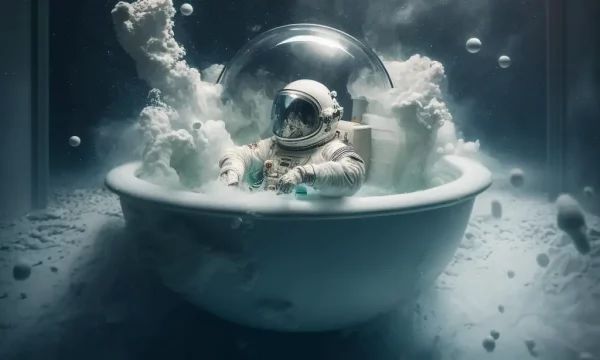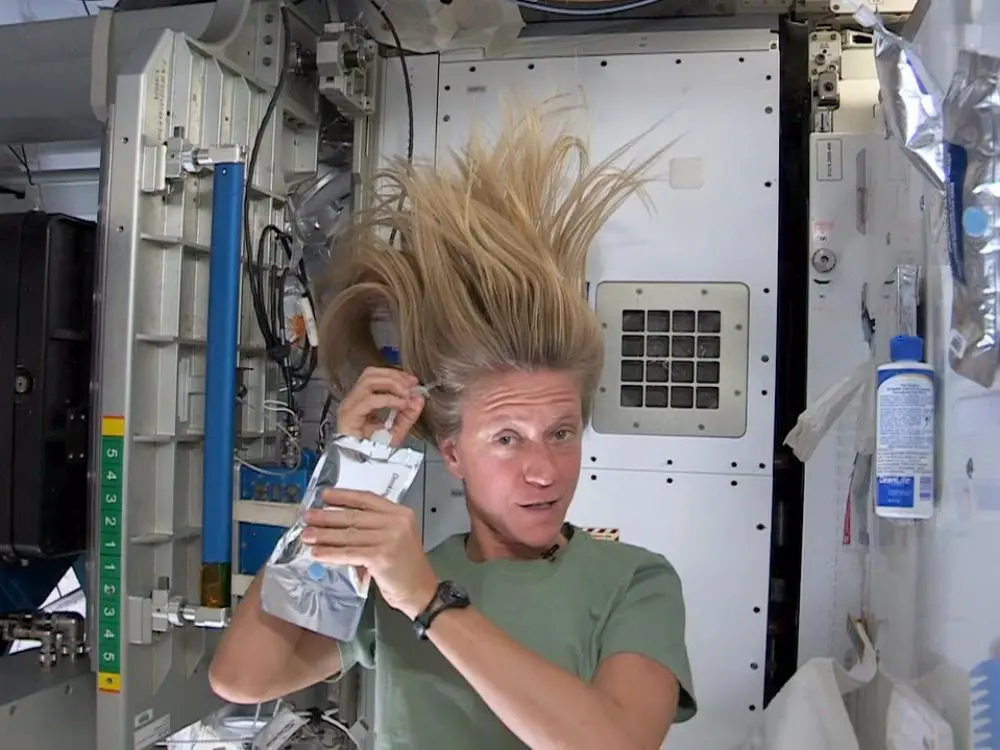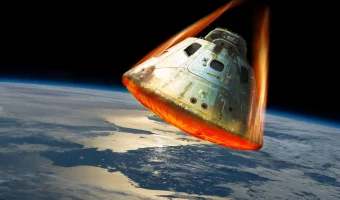
Weightless Wash: How do astronauts “shower” in space?
Last Updated: February 28, 2023
Scrubbing up for our regular shower is important for maintaining good personal hygiene for our physical and mental health, no matter what our day looks like. However, being weightless, how do astronauts shower in space?
Let’s explore the challenges and solutions of showering space today and into the future.
The Challenges of Showering in Space
Being weightless in space provides many advantages (such as no heavy lifting and being able to float instead of walking), but also many challenges. We’ve discussed in a previous article how astronauts train for the environment of space using Earth equivalents such as the “Vomit Comet” and the underwater facilities of the Neutral Buoyancy Lab to be able to live and work in space. We’ve also discussed the challenges and current solutions of cleaning up in space, including specialized procedures and equipment to prevent materials and molecules from floating around on the station, dirtying the environment and potentially threatening the health and safety of both astronauts and equipment on board. That article also included the challenge of keeping astronaut bodies clean to stay healthy. Feel free to check out those articles for more detailed background information for today’s article. Today, let’s delve into the specific challenges of showering in space.
Bathing is a common and necessary part of our daily routine to ensure that we stay clean. As detailed in the Cleaning Up In Space article, “Maintaining personal hygiene helps ensure your body clears itself of any buildup of microbes, skin cells, yeast (a natural byproduct in our skin), and general grime built up over time. If these are left on our bodies, they will not only contaminate other objects, but clog up our natural systems, making it harder for our bodies to maintain homeostasis.”
Bathing is an important part of keeping our bodies clean and showers are the common method on Earth, but the weightless environment of space from being in constant freefall around Earth does not provide a good environment for a shower. Everything floats in space, from big objects and even humans to tiny molecules. There is no gravity to pull water to the ground and over our bodies as happens when we shower here on Earth. In addition, liquids can cause a number of issues including creating a moist environment for bacteria to thrive and potentially harming equipment on the space station. Therefore, standing under a shower of water provides a number of concerns including safety and logistics. Containing floating water molecules in a safe chamber that will not be harmed by the water and allows the astronaut to collect the molecules to wash and then effectively remove the water molecules and moisture is quite a challenge.
The International Space Station is about as big as a six-bedroom house packed with experiments, exercise equipment, and other equipment needed to keep the station running and habitable. It is tight quarters with most of the space being prioritized for equipment for work and survival versus comfort for the astronauts. There is a lack of privacy in general as they have to do everything together in limited quarters with only small private quarters to retreat. There is the Waste and Hygiene Compartment (WHC) in the U.S. segment in Node 3 (in addition to the toilet facility on the Russian side if needed) with specially designed equipment (including a toilet) to be able to perform those functions in space utilizing suction and fans with little room for error and a lot of logistics to clean up any messes. It’s essentially similar to a stall in a public bathroom which provides some but not a lot of privacy. And they use that same area to shower. It’s similar to having to shower in an airplane bathroom stall. Crews did work with ground control to add an additional hygiene area in the Permanent Multipurpose Module (PMM) bay one with hygiene curtains where they can wash up if they need to with similarly tight quarters.
In addition, it’s not easy to send supplies to space and so space agencies have to be very strict but efficient about what is delivered. Here on Earth, weight is a huge factor in launching the rocket, so they have to ensure they stay within their weight parameters while providing astronauts and the station with the necessary materials. They carefully research what will work in space for hygiene and calculate the right amount. They can’t easily run to the store for more if they run out so they need to use everything as efficiently as possible.
The Solutions for Showering in Space
Astronauts on the Gemini and Apollo missions used a very simple sponge bath similar to what you might do if you were camping without shower facilities with a towel, soap, and very limited water since they had no way to recycle or reuse it. It worked okay, but they came back fairly ripe.
When NASA launched the first American space station (Space Lab) in 1973, NASA wanted the astronauts to have a better hygiene experience. They designed a “zero-gravity” shower that featured a floor-to-ceiling cylindrical tube shower curtain, a vacuum system, and foot restraints on the floor to keep astronauts in place. After securing their feet in the restraints, astronauts would attach a portable pressurized water bottle to a hose and shower head in the ceiling. Then they would pull up the cylindrical shower curtain and secure it. Then they would “spray” themselves with water, lather up, and rinse from water coming out of the bottle showerhead, strictly rationed to 6 pints (2.8 liters) for their weekly shower. Then they had to vacuum up all of the water and soap bubbles into a collection bin before undoing the cylindrical curtain to exit. Reviews for the shower were mixed as it was a nice experience for the astronauts and left them feeling clean and refreshed (and smelling better), but the process was tight, cumbersome, and time-consuming at about 2 to 2.5 hours per shower, which overall was deemed inefficient and not worth the effort.
Due to these logistical concerns, “showering” during the Space Shuttle era and today on the International Space Station has returned to the previously utilized sponge baths, but with some improvements. NASA has designed a number of different options for astronauts to shower with so they can pick what they prefer, but in general, they squeeze a little water from a specially designed pouch onto a washcloth with some rinseless soap (or use a towel that already has soap infused into it or a soapy water bag with a towel) and clean themselves. Thankfully, due to surface tension, the soap will blob up but mostly stay on the surface of your skin if you don’t move around too much. Prior to the shower, some astronauts briefly heat up the water or soapy water bags in the food warmer to have a warm shower. For hair, they utilize a dry shampoo that doesn’t require water to rinse. Again, they squeeze a little into their hair along with a little squirt of water along their scalp and work it into the scalp with their fingers or a washcloth and then comb it through to the ends of their hair. With long hair, the strands will float up and around, which while a little more cumbersome, still can work as long as you are extra careful and utilize your fingers and a comb and dry with a towel. They use a towel to dry off any areas of their body that need it and evaporate any excess water with a nearby airflow system.
Again, all of this has to be done while floating and trying to prevent anything including water, the pouches of water and soap/ shampoo, washcloths, towels, etc. from floating away and causing trouble. Cleaning up after a “shower” is extremely important even if not much water is being used. In addition, objects can be attached to any surface with Velcro, but again this requires attention and care to ensure these potentially wet items don’t go floating away.
As previously mentioned, supplies are a concern in space. New supplies need to be sent up in a rocket launch, which costs money, time, and resources. Astronauts need water to live so it is a necessity, but they need to make sure they are being efficient with their use and not wasting any. The big difference between ISS showers and the Apollo and Gemini sponge baths is that they can use more water since the ISS utilizes a water reclamation and recycling system that reuses about 93% of the water it receives, coming from all sources including showers and even the toilet utilizing a heated spinning distiller to remove contaminants without the presence of gravity.
Here on Earth, even a five to ten minute shower uses 10-25 gallons of water and we don’t have to worry about the water floating away! Therefore, the sponge-bath method for showering on the ISS allows less water to be used, but enough to clean effectively (only about 5-6.75 ounces or 150-200 milliliters), and it is easier to reclaim that water from the towels as they air dry and the water molecules are sucked into the reclamation and recycling system to be used again. They only receive a new towel about every five days so they reuse them for showering and other hygiene purposes a few times and then they use them as exercise towels or cleaning towels until they need to be trashed. This allows them to efficiently reuse even the towels just like you may downgrade a bath towel to a cleaning towel.
In the above video, Samantha Cristoforetti demonstrates how astronauts maintain good hygiene onboard the ISS.
The Future of Showering in Space
While the current methods work well on the ISS in terms of efficiency of time and resources while also keeping the crew clean, just like with everything else related to space travel, research is constantly looking to provide the best solution. Researchers and trainers are constantly working with past and current astronauts to pass along the best “hacks” to personal hygiene in space, even adapting the station where necessary to provide better facilities for the crew such as the additional hygiene area.
They are currently discussing and conducting research on the best methods of personal hygiene for longer spaceflight missions such as to the Moon and Mars. When we are actually on the Moon or Mars, the potential for showers increases as they will have some gravity though less than ours. This gravity will help to allow water to fall in at least a similar way to here on Earth. Research is being done on how these shower facilities will need to be designed to provide the most effective and efficient shower that can easily be cleaned in those conditions which will need to be weighed against other factors to determine if it is a better solution than the current method on the ISS. However, there are currently some released proposals that include space for a shower on particularly a Mars habitat, showing that there is at least interest in the prospect.
In regards to the time needed to travel to these locations in space where the astronauts will be weightless, similar concerns and challenges apply to what astronauts experience on the ISS. For the trip to the Moon (about 3 days) they will likely not deviate from the ISS model. For the trip to Mars lasting 6-8 months, one-way, they will have to decide if having a more luxurious shower system (likely similar to the Space Lab solution) will provide enough benefit to physical and mental health to use less efficient methods.
Most space station missions are about six months while a round-trip mission to Mars would likely be about 15 months minimum, which would be a long time without a real shower. Improved hygiene methods will help reduce the risk of someone becoming sick and help keep mental health stable, both of which are solid reasons to at least research the negative impacts that a more advanced shower system would require, which is exactly what NASA and other space agencies are doing.
The primary challenges with bathing in space are ensuring privacy on a spacecraft with tight quarters, utilizing water efficiently while still ensuring that the body is cleaned effectively, and providing more of a mental health benefit to bathing. Balancing all of these factors is crucial. Bathing on the ISS is purely utilitarian and for hygienic purposes whereas here on Earth a hot shower or bath can provide therapeutic benefits. And again, while six-month missions without a real shower, but efficient sponge baths are perfectly healthy and doable, longer missions that will be increasingly more stressful may require different solutions to help astronauts with their physical and mental health.

Despite having long hair and being in a weightless environment, astronaut Karen Nyberg still manages to keep her mane clean and well-maintained. Credit: NASA
Conclusion
Maintaining personal hygiene in space is vital and yet complicated. Showers are key in keeping the body healthy and weightlessness creates challenges for the physics of water falling on your body. While different methods have been tried over the years, the current and best method is sponge/ towel baths that require minimal water and soap, allowing astronauts to clean their bodies while mitigating the impact of water in space that could cause issues with the hardware and environment of the space station.
Training and innovations such as specially formulated soaps, soap-enriched towels, special air ventilation systems, and a highly efficient water reclamation system help to provide an efficient system for bathing in space. Research is currently being done to evaluate what changes, if any, will be utilized in longer-term human spaceflight missions such as to the Moon and Mars both on the surfaces and for the long trip to and from Mars.
The mental and physical health benefits over such a long mission are being evaluated against other factors to determine whether they outweigh the costs of installing and maintaining a “zero-gravity” shower system in terms of time, resources, and space.
All in all, personal hygiene in space is a top priority for astronauts, and space agencies are continuously researching options to determine the best methods for bathing while in space.

Sarah Hoffschwelle is a freelance writer who covers a combination of topics including astronomy, general science and STEM, self-development, art, and societal commentary. In the past, Sarah worked in educational nonprofits providing free-choice learning experiences for audiences ages 2-99. As a lifelong space nerd, she loves sharing the universe with others through her words. She currently writes on Medium at https://medium.com/@sarah-marie and authors self-help and children’s books.
Explore more astronaut stories 👨🚀
This page is part of our collection of articles about astronauts. If you enjoyed the read, then you’ll love the following articles.




There are three main reasons why astronauts may have difficulty walking on land after spending so much time in a microgravity environment.
